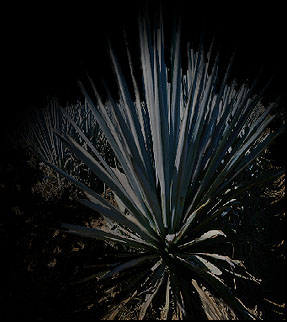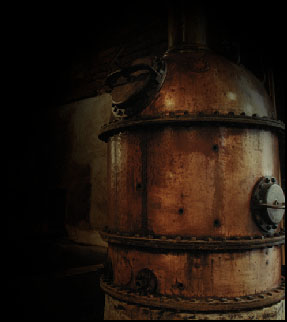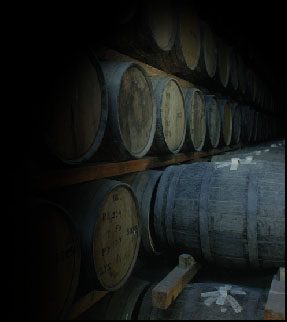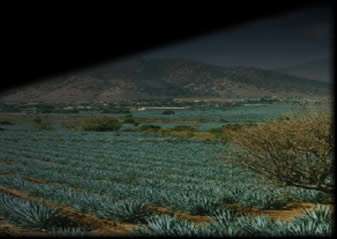The
Making of a Tequila
Tequila
is not made from the typical grains or fruits most alcoholic beverages
are made from. It is distilled from the roasted centre (piña)
of the blue agave (maguey) plant - the agave tequilana weber azul
- one of 136 species of agave that grow in Mexico (with 26 sub-species,
29 varieties and 7 types). It has a lifespan of 8-14 years, depending
on soil, climate and cultivation methods. The blue agave was classified
by German botanist F. Weber in 1905. It's commonly - and mistakenly
- called a cactus, but it is really a succulent that belongs to
the lily (amaryllis) family. It is sometimes known as cabuya,
maguey mezcal, mexic, pita and teometl. The agave used in mezcal,
although similar, is harvested younger than the tequila agave.
Most
of Jalisco state where tequila is made is a high plateau that
averages 7,500 feet above sea level,
with sandy, mineral-rich red soil in the highlands, and black
earth in the valleys. It is a mountainous, hilly region - but
agave grows best above 1,500 metres. According to some, the best
agave plants grow on the slopes of the extinct volcano beside
the town. Others say the best tequila is made from agave taken
from the highlands to the east because highland agave tend to
grow larger. One variety, the Arandas agave, is very large and
considered a premium plant that commands more money. Another term
for large agave is mano larga or long hand. It may also
be that highlands distillers tend to use more traditional production
methods to manufacturer smaller quantities of tequila, while those
around the town are more modern and produce more export product
- usually mixto (made with sugars added to the fermenting agave
to increase the alcohol content).
 Once
all tequila had to be made by law in Jalisco state. Although that
has been changed for more than 20 years, only two distilleries
are currently in business outside Jalisco. The owners of La Gonzaleña
- makers of Chinaco - fought a long battle to get the laws changed
to permit tequila to be made outside Jalisco. They won their fight
only in 1977, and now operate the sole distillery in the northeast
state of Tamaulipas. The other distillery outside Jalisco is Tequilera
Corralejo, which opened in 1996 in the city of Penjamo, in Jalisco's
neighbouring state of Guanajuato.This distillery is named after
one opened in the state in 1755. Blue agave for tequila use may
also be grown in the states of Nayarit, Guanajuato and Michoacan.
Once
all tequila had to be made by law in Jalisco state. Although that
has been changed for more than 20 years, only two distilleries
are currently in business outside Jalisco. The owners of La Gonzaleña
- makers of Chinaco - fought a long battle to get the laws changed
to permit tequila to be made outside Jalisco. They won their fight
only in 1977, and now operate the sole distillery in the northeast
state of Tamaulipas. The other distillery outside Jalisco is Tequilera
Corralejo, which opened in 1996 in the city of Penjamo, in Jalisco's
neighbouring state of Guanajuato.This distillery is named after
one opened in the state in 1755. Blue agave for tequila use may
also be grown in the states of Nayarit, Guanajuato and Michoacan.
The
agave plants are grown in cultivated orchards called potreros
(pastures, also called agave fields, or campos de agave -
also called huertas, or groves, in the Los Altos
region). Traditional plantings may still have corn and beans growing
between the rows. Agaves are grown from shoots (mecuates
or hijuleos) taken from the adult plants at the start
if the rainy season in their fourth to sixth year (when the shoots
themselves are at least a year old, and about the size of a leek
or small onion). The shoots are left in the fields to dry out
for about a month before they are planted in a nursery for another
year, after which they are transferred to the fields. Sometimes
the shoots are planted right away, just before the rainy season,
so they can get established in the soil more quickly. The agave
may also be grown from seed, although this is generally not done
any more. There can be anywhere from 1,000 to 2,000 plants in
an acre.
The
agave plant takes at least eight years to reach the stage where
it is suitable for fermentation and may be left for up to 12 before
harvesting; the more mature, the better its natural sugars (agave
sazon means ripened). During this time it is pruned (barbeo),
cutting the points of the leaves with machetes to encourage the
piña to grow. Some farmers also use a technique called 'shotgun
plowing' (barbeo de escopeta) to induce premature ripening
of plants, but most fields are hand grown and cultivated, using
traditional methods passed down from generation to generation.
Modern producers often spray agave fields with fertilizers and
pesticides. Most use farm hands to meticulously control the weeds
by hand. Fields are not irrigated; the plants depend entirely
on the rainy season for moisture. Experiments with irrigation
showed the larger plants that resulted did not produce any more
agave sugars.
The
part of the plant that is used for tequila is the heart (root),
or piña (also called the head, or cabeza), which
looks like a large pineapple or pinecone. It starts underground,
but soon pushes its way into the light. A mature piña usually
weighs 80 to more than 300 pounds (although most are under 200
pounds). Even 500-lb. piñas have been cultivated in the highlands,
although they are rare.
Left
to grow in the wild, these piñas would extend a tall shoot, 15
feet high or more, with pale yellow flowers at the top. The wild
flowers are pollinated by local long-nosed bats (Leptonycteris
nivalis), and then after producing 3,000-5,000 seeds, the plant
would naturally die. The dwindling population of these bats is
an environmental concern and may spell serious trouble in the
future for wild agaves used for fibre, pulque and mezcal.
The
young, tender flower stalk is called a quiote or
quixotl, and is picked and eaten as a vegetable. The stalk
is not allowed to grow on cultivated agaves, because it uses up
the nutrients in the plant to produce its seeds, and is cut so
the piña grows fatter. The piña is ripe when it starts to shrink
and develops a maroon tinge, and red spots appear on the leaves.
When
ready for harvesting, the carbohydrate-rich piña is cut from its
stalk. Then the 200 or more 6-7 foot spiky and thorn-covered leaves
(pencas) that stand out from the agave are cut away from
the heart by a jimador or harvester (from the Nahuatl
word jima, or harvest), using a sharp, long-handled tool called
a coa. The skill of harvesting is passed down from father
to son and some fields have three generations of jimadors working
in them. Methodical, but efficient, a good jimador can harvest
more than a ton of piñas in a day. He loads the heavy piña on
a truck, Full truck loads are carried to the factory (fabrica)
where the piñas are usually quartered or halved before baking.
The remainder of the agave has no other uses. Harvesting is done
year-round because the plants mature at different stages in the
fields. Some large distillers pick young agaves, but others, like
Herradura, use only plants 10 years or older.
Some
distillers will 'pre-cook' the piñas to rid them of external waxes
and solids that may be retained in the penca. These can make a
bitter or unpleasant juice. The steam-injected autoclaves used
in modern distilleries also wash away any external materials from
the piñas. Farmers who sell piñas by weight may leave on more
of the penca, while those paid daily wages by the producer are
more likely to cut them off closer to the piña. It takes about
7 kilograms of piña to produce 1 litre of 100% agave tequila -
which means the average piña can make 60-100 litres. Small distillers
may simply purchase agave syrup to ferment, without any of the
intervening processes.
Traditional
distillers (tequilleros) let the piñas soften in steam
rooms or slow-bake ovens for 50-72 hours. The traditional stone
or brick oven is called a horno - hence the name of Sauza's
Hornitos. This bakes the agave to process its natural
juices (baking, or roasting is tatemar) at around 140-185
degrees F. This slow-bake process softens the fibres and helps
keep the agave from caramelizing, which adds darker and bitter
flavours to the juice and reduces the agave sugars. Baking in
ovens also helps retain more of the natural agave flavours. Here's
where mezcal and tequila part ways: mezcal piñas are baked slowly
in underground pits, rather than steamed.
Many
large distillers prefer to cook their piñas faster in efficient
steam autoclaves and pressure cookers in as little as a single
day (8-14 hours). The baking process turns the complex carbohydrates
into fermentable sugars and softens the piña so they can easily
release their juice. Fresh from the oven, the piñas taste a bit
like a sweet potato or yam, with a mild tequila aftertaste. In
traditional distilleries, the piñas are allowed to cool for another
24-36 hours after steaming, then they are mashed to separate the
pulp (bagazo or bagasse) from the juice (although
some traditional distillers keep them together during the fermenting).
Originally,
the manufacturers beat the piñas with mallets to break them up
once they were soft and cool. Then they moved to the tahona,
a giant grinding wheel that can weigh up to two tons, operated
by mules, oxen or horses (nowadays more likely by a tractor).
Modern distilleries use a mechanical crusher, or shredder, like
a giant wood-chipping machine to process out the waste bagazo
(usually given away as animal food or fertilizer). Using
one of these methods, the piñas are minced and strained to remove
the juices (called aquamiel, or honey water),
them mixed with water in large vats.
The
resulting wort (tepache) is sprinkled with yeast. Traditionally
this is a yeast that grows naturally on the leaves of the plant,
but today it may be a cultivated form of that wild yeast or even
a commercial brewer's yeast (natural fermentation from airborne
yeasts is sometimes allowed in some traditional mezcals and pulque).
Tequila Herradura boasts it is the only company that uses 'natural
fermentation.' However, according to a story in the Wall Street Journal (May,
1999) when yeasts are used to speed fermentation, some distillers
must add antibiotics to kill unwanted microbes that result.
However, according to a story in the Wall Street Journal (May,
1999) when yeasts are used to speed fermentation, some distillers
must add antibiotics to kill unwanted microbes that result.
The
must (mosto) is left to ferment in wooden or stainless
steel tanks. This can naturally take seven to 12 days, but modern
plants add chemicals to accelerate yeast growth so fermentation
only takes two to three days. Longer fermentation results in a
more robust body. Fermented must may also be used as a starter
mixture for the next batch.
Sometimes
the must is fermented with the residual pulp from the piñas left
in it to impart the most flavour to the liquid - another traditional
practice - but more often the pulp is disposed of. It may be sold
to construction firms for adding to bricks or as packing material.
Some
manufacturers use cane or brown sugar cones (piloncillo)
to speed fermentation to be able to use immature and fewer plants.
This type of tequila can be sold in bulk for shipping out of the
country, and can be bottled anywhere, including other countries
where the regulations regarding agave content are not necessarily
maintained. These tequilas are called mixto, and will
not be labelled 100% agave, which purists demand. After fermentation
is finished, the must may be left another 12 hours to richen and
settle before distillation.
The
result of fermentation is a liquid with about 5-7% alcohol. It
is then distilled twice in traditional copper pot stills called
alambiques, or in more modern stainless-steel column
stills. The best copper stills are said to come from Tomelloso,
in Spain. Distillation takes four-eight hours. The first distillation
takes 11/2-2 hours. It is called the ordinario and is
about 20% alcohol. The second distillation takes 3-4 hours. It
has about 55% alcohol. It has three components: the cabeza,
or head, has more alcohol and unwanted aldehydes, so it is discarded.
The middle section is the El corazon, the heart, which
is the best part and saved for production. The end is the colos,
or tails, which is sometimes recycled into the next distillation
to make it more robust, or may also be discarded. The residue,
or dregs (vinazas) is discarded. Most mezcal is only
distilled once, although some premium brands now offer double
distillation.
All
tequila is clear right after distillation. The colour comes later,
from aging in wooden barrels (barricas) or from additives
like caramel (in mixto only) or wood essence. Before bottling,
most tequila is filtered through activated carbon or cellulose
filters.
One
premium blend offers triple-distillation, although some connoisseurs
say it comes with a subsequent loss of flavour. Most distillers
add de-mineralized water to bring the proof down to 80 (40% alcohol),
although some will stop the process at the required proof. Reposado
and añejo tequilas will be stored in wooden casks. These barrels
are generally purchased used from American distillers (bourbon
barrels are the most prized but some distillers use sherry barrels,
whiskey barrels, cognac barrels and even new oak barrels to impart
sharper flavours) and older ones may be 50 years or older and
still in use. They will be stored in warehouses or bodegas.
Blanco will remain in stainless steel tanks until bottling. It
may also be bottled immediately after distillation.
 The
passion for premium aged tequilas that look like brandies has
led some distillers to age them longer in oak barrels to absorb
the maximum colouring. Others simply add colouring to create the
impression of age - which may also affect the flavour. Some distillers,
like Centinela, disdain the use of any such additives. Note too
that changing barrels (replacing old ones with new) can also darken
a tequila and change its flavour until the barrels are 'broken
in.' The colour of a tequila does not necessarily reflect either
age or quality.
The
passion for premium aged tequilas that look like brandies has
led some distillers to age them longer in oak barrels to absorb
the maximum colouring. Others simply add colouring to create the
impression of age - which may also affect the flavour. Some distillers,
like Centinela, disdain the use of any such additives. Note too
that changing barrels (replacing old ones with new) can also darken
a tequila and change its flavour until the barrels are 'broken
in.' The colour of a tequila does not necessarily reflect either
age or quality.
The
final product is usually blended with other barrels of a similar
age to create a consistency of taste and aroma. Representatives
of the Tequila Regulatory Council oversee the production to ensure
the distillers meet the standards and quality controls in place
under Mexican legislation. The resulting mix is then bottled or
tanked for bulk shipments. A few 'single barrel' tequilas are
available in the premium market. All 100% agave tequilas must
be bottled in Mexico and marked "Hecho en Mexico" - made
in Mexico. Only mixto tequila is allowed to be sold in bulk and
bottled outside the country.
"Distilled
from melancholy and from lucidity; from an intense love for good;
from a need to bite into the earth and hear the poetry of the
people's song."
Author
unknown, quoted in the Guia de Tequila, published by
Artes de Mexico,1998.
Tequila
production is facing a crisis in production - the combined result
of a plague of diseases and pests with spiraling agave costs and
an agave shortage. The looming shortage of agave has seen several
distillers drop their low-end brands in favour of higher-priced
premium products. The shortage could also seriously impact mezcal
producers because tequila manufacturers are already buying agave
from Oaxaca state to shore up their dwindling supplies. Mezcal
producers face a 40% increase in costs due to the demand by tequila
manufacturers for the agaves from Oaxaca. This appears to violate
the Mexican NORMAS and DOT standards for tequila - but the industry
seems remarkably quiet in its response.


 Once
all tequila had to be made by law in Jalisco state. Although that
has been changed for more than 20 years, only two distilleries
are currently in business outside Jalisco. The owners of La Gonzaleña
- makers of Chinaco - fought a long battle to get the laws changed
to permit tequila to be made outside Jalisco. They won their fight
only in 1977, and now operate the sole distillery in the northeast
state of Tamaulipas. The other distillery outside Jalisco is Tequilera
Corralejo, which opened in 1996 in the city of Penjamo, in Jalisco's
neighbouring state of Guanajuato.This distillery is named after
one opened in the state in 1755. Blue agave for tequila use may
also be grown in the states of Nayarit, Guanajuato and Michoacan.
Once
all tequila had to be made by law in Jalisco state. Although that
has been changed for more than 20 years, only two distilleries
are currently in business outside Jalisco. The owners of La Gonzaleña
- makers of Chinaco - fought a long battle to get the laws changed
to permit tequila to be made outside Jalisco. They won their fight
only in 1977, and now operate the sole distillery in the northeast
state of Tamaulipas. The other distillery outside Jalisco is Tequilera
Corralejo, which opened in 1996 in the city of Penjamo, in Jalisco's
neighbouring state of Guanajuato.This distillery is named after
one opened in the state in 1755. Blue agave for tequila use may
also be grown in the states of Nayarit, Guanajuato and Michoacan.
 However, according to a story in the Wall Street Journal (May,
1999) when yeasts are used to speed fermentation, some distillers
must add antibiotics to kill unwanted microbes that result.
However, according to a story in the Wall Street Journal (May,
1999) when yeasts are used to speed fermentation, some distillers
must add antibiotics to kill unwanted microbes that result. The
passion for premium aged tequilas that look like brandies has
led some distillers to age them longer in oak barrels to absorb
the maximum colouring. Others simply add colouring to create the
impression of age - which may also affect the flavour. Some distillers,
like Centinela, disdain the use of any such additives. Note too
that changing barrels (replacing old ones with new) can also darken
a tequila and change its flavour until the barrels are 'broken
in.' The colour of a tequila does not necessarily reflect either
age or quality.
The
passion for premium aged tequilas that look like brandies has
led some distillers to age them longer in oak barrels to absorb
the maximum colouring. Others simply add colouring to create the
impression of age - which may also affect the flavour. Some distillers,
like Centinela, disdain the use of any such additives. Note too
that changing barrels (replacing old ones with new) can also darken
a tequila and change its flavour until the barrels are 'broken
in.' The colour of a tequila does not necessarily reflect either
age or quality.